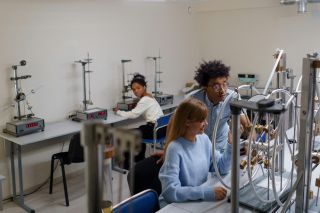Education
Gender Diversity in Physics Classes Benefits Men and Women
A new study shows that belongingness intervention increases grades for all genders.
Posted March 24, 2024 Reviewed by Ray Parker
Key points
- Women are underrepresented in STEM fields.
- Researchers show a brief, belonging intervention in physics classrooms improved learning for all students.
- Gender diversity and belongingness interventions can lead to better grades for all students.
.jpg?itok=PV_CEK9T)
Although more women than men in the U.S. earn college degrees, striking gender gaps remain in specific disciplines. Men significantly outnumber women in several STEM (science, technology, engineering, and mathematics) fields, most notably physics, math, computer science, and engineering. Researchers have described the climate in these STEM settings as “chilly” to women, marked by assumptions that women are less capable than men.
A new study of several thousand students across 124 introductory physics classrooms provides evidence that a brief belongingness intervention combined with a gender-diverse classroom setting can improve learning outcomes for all students—regardless of their gender.
At the beginning of this five-year study, researchers at the University of Pittsburgh randomly assigned a set of physics discussion classrooms to participate in a belongingness intervention. The rest of the discussion sections proceeded with “business as usual.” The belongingness intervention took place during the second week of the academic term and was led by the students’ discussion section instructor. The intervention was brief and straightforward.
First, the instructor spent a few minutes explaining that it was normal for many students to experience a rough transition to college. She explained that many students wonder whether they belong or whether they are smart enough to succeed. In addition to explaining that these experiences are normal, the instructor emphasized that things tend to get better over time as students adjust to college.
Next, students spent around 10 minutes on an individual writing task, focusing on the challenges they had experienced so far during their transition to college. After the writing exercise, the instructor shared quotes from stories ostensibly written by juniors and seniors about their experiences with self-doubt and how they overcame these feelings through collaboration, persistence, and asking for help.
For example, one of these stories read:
“When I first got here, I was worried because I was really struggling with some of the physics concepts. It felt like everyone else was doing just fine, but I just wasn’t sure if I was cut out for a physics course. At some point during the first semester, I came to realize that, actually, a lot of other students were struggling, too. And I started to look at struggling as a positive thing. After I struggled with a hard problem and then talked to other classmates and my TA [teaching assistant] about the solution—I realized that all that effort was worth it because it helped me learn and remember much more.”
Students were given copies of these stories and spent a few minutes discussing the themes (along with what they wrote about) with a group of three to four classmates. Finally, the class came together as a whole to discuss their thoughts with the instructor.
That was the end of the intervention. The rest of the term proceeded with “business as usual” for all students. At the end of the term, students completed measures of belongingness (e.g., “I feel like I belong in this class.”) and physics growth mindset. A growth mindset suggests you think you can get better at physics with effort (e.g., “Anyone can become good at solving physics problems through hard work.”). A fixed mindset indicates you believe people are either good at physics or they’re not.

This single-shot intervention led to some remarkably positive outcomes for students. Compared to students in control group classrooms, those who received the belongingness intervention were less likely to work alone or in single-gender groups and more likely to work in mixed-gender groups or a gender out-group (i.e., a group with all other members being of another gender). This finding held for both men and women.
Typically, researchers find that men in physics classrooms score much higher on measures of belonging than women. This brief belongingness intervention made that gap shrink by 47%. In other words, at the end of the term, men were still more likely than women to feel that they belonged in the physics class, but the gap was much smaller in classes that received the belongingness intervention.
This improvement in belongingness was most striking for women in classrooms with more gender diversity. Gender diversity also mattered for effects on physics growth mindset, but these results showed a different pattern. Women in low-gender diversity classrooms who received the intervention reported a more fixed mindset for physics at the end of the term. The researchers suggested that perhaps the belongingness message “rang hollow” for women who saw few other women present in the classroom.
The most impressive finding from the study was that both men and women in gender-diverse classrooms who received the intervention earned higher grades in the course. These same students also received higher first-year grade-point averages (GPAs) (around .14 points across all of their courses), evidence of the broad and long-term effect of this brief intervention.

The intervention wasn’t magic. Its primary benefits only seemed to emerge in classrooms with reasonable levels of gender diversity, and some of the key measures did not show improvement as a result of the intervention. However, the fact that the intervention is so easy to administer and seems to have broad effects on students’ academic success is promising. Overall, this study is a reminder that the benefits of gender diversity may not emerge when one gender feels they don’t belong. The benefits of a belongingness intervention may disappear in settings where group members see little in the way of gender diversity when they look around.




